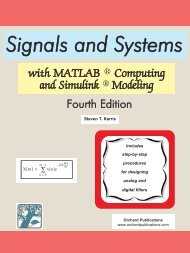COMPUTING
Second Edition - Orchard Publications
Second Edition - Orchard Publications
- No tags were found...
You also want an ePaper? Increase the reach of your titles
YUMPU automatically turns print PDFs into web optimized ePapers that Google loves.
5.18 External Frequency CompensationExternal Frequency CompensationGeneral purpose op amps like the 741 op amp, are normally internally frequency compensated sothat they will be stable with all values of resistive feedback. Other types of op amps like the 748 opamp, are without internal frequency compensation and require external connection of frequencycompensating components to the op amp. Typically, the compensating components alter the openloop gain characteristics so that the roll−off is about 20 dB ⁄ decade over a wide range of frequencies.Figure 5.69 shows a typical op−amp with external frequency compensation where 3 externalcapacitors can be used as frequency compensating components. With the appropriate selection ofcapacitors , , and , we can alter the frequency response as shown in Figure 5.70.C 1 C 2 C 3Figure 5.69. Typical op amp with externally connected capacitors for frequency compensation10090No compensation80Open-loop gain (dB)706050403020With compensation5.19 Slew Rate10010 3 10 4 10 5 10 6 10 7 10 8Frequency (Hz)Figure 5.70. Frequency responses with and without external frequency compensationThere is a limit to the rate at which the output voltage of an op amp can change. Therefore, manufacturersspecify a new parameter referred to as the slew rate. By definition, the slew rate (SR) isthe maximum rate of change of an output voltage produced in response to a large input step functionand it is normally expressed in volts per microsecond, that is,Electronic Devices and Amplifier Circuits with MATLAB Computing, Second EditionCopyright © Orchard Publications5−45







